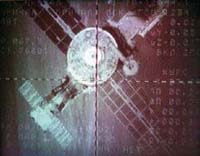 |
Science@NASA Huntsville AL (SPX) Jun 29, 2009 The crew of the International Space Station (ISS) is about to get a new "eye-pod." The Tranquility node headed for the space station early in 2010 will feature a viewing dome unlike any other window ever flown in space. The dome, called the Cupola, is literally studded with windows for observing Earth, space, and the marvelous expanse of the ISS itself. The Cupola, named after the raised observation deck on a railroad caboose, is designed as an observation platform for operations outside the station--e.g., robotics, spacewalks, and docking spacecraft. Computer workstations inside the dome will give astronauts full control over the space station's robotic arm and dexterous manipulator, while the windows offer unparalleled views of these devices in action. It's also a place where astronauts can unwind. "Crews tell us that Earth gazing is important to them," says Julie Robinson, the ISS Program Scientist at NASA's Johnson Space Center. "The astronauts work hard up there and are away from their families for a long time. Observing the Earth and the stars helps relax and inspire them." Until now, space station astronauts have been confined to looking out small portholes or at best the 20-inch window in the US Destiny Laboratory. The Cupola will dramatically expand their view. "The Cupola's 80-cm diameter circular top window is the largest window ever built for space," says Robinson. "Rather than peering through a little porthole, the Cupola will allow a stunning look at the cosmos and unprecedented panoramic views of Earth. Astronauts will share these views with the world through photographs taken through the windows and posted online." This could lead to scientific discoveries: "By photographing oblique views with different sun angles, the astronauts can use the Cupola to give scientists a view of the Earth that is not available from satellites," she adds. Astronaut photographs of Earth have been used to understand Earth processes such as melting of icebergs, noctilucent clouds, dust storms, and the structure of hurricane eyes. It seems fitting that the space station is getting the Cupola around the time of the 40th anniversary of the Apollo program. Apollo astronauts, like the space station crew, cherished the experience of gazing back at the planet they left behind. Apollo 14 moonwalker Ed Mitchell had this to say: "Suddenly, from behind the rim of the moon, in long, slow-motion moments of immense majesty, there emerges a sparkling blue and white jewel, a light, delicate sky-blue sphere laced with slowly swirling veils of white, rising gradually like a small pearl in a thick sea of black mystery. It takes more than a moment to fully realize this is Earth . . . home." From the Cupola, it's going to look better than ever. Share This Article With Planet Earth
Related Links Science@NASA Station at NASA Station and More at Roscosmos S.P. Korolev RSC Energia Watch NASA TV via Space.TV Space Station News at Space-Travel.Com
 Progress To Undock From ISS June 30
Progress To Undock From ISS June 30Moscow (RIA Novosti) Jun 25, 2009 Russia's unmanned Progress M-02M cargo spacecraft will undock from the International Space Station (ISS) on June 30 and later be dropped into the Pacific, mission control said on Wednesday. The modified version of the standard Progress craft docked on May 13, bringing 2.5 tons of supplies to the orbiter, including food, water, scientific equipment and messages for the three-member crew. ... read more |
|
| The content herein, unless otherwise known to be public domain, are Copyright 1995-2009 - SpaceDaily. AFP and UPI Wire Stories are copyright Agence France-Presse and United Press International. ESA Portal Reports are copyright European Space Agency. All NASA sourced material is public domain. Additional copyrights may apply in whole or part to other bona fide parties. Advertising does not imply endorsement,agreement or approval of any opinions, statements or information provided by SpaceDaily on any Web page published or hosted by SpaceDaily. Privacy Statement |